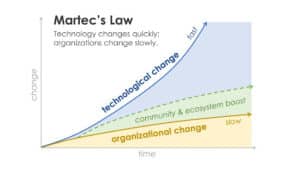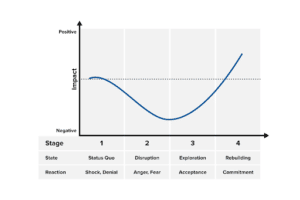Improved efficiency… meeting customer expectations… financial returns… workforce diversity. The benefits that come from investing in new tools for your organization are endless.
But just because you invest in a new tool doesn’t ensure that they will be successful.
In fact, 70% of all digital transformations fail. The number one reason? Because organizations fail to implement a successful change management strategy.
But It doesn’t have to be this way.
The truth is, people process change in a variety of predictable stages. By understanding The Change Curve and implementing it into your RevOps change management process you can better help your GTM teams successfully adopt your new tools to pioneer your revenue efforts forward.
Below, we’re covering everything you need to know about The Change Curve framework and how to make it work for your organization.
What is the Change Curve Model?
The change curve is a model that was developed by Elisabeth in the 1960s to explain the different emotional phases people phase when experiencing change stemmed from grief and bereavement.
But since its development, the methodology has transitioned more from a personal focus to analyzing the impact of technological change within organizations. The premise of the modern day Change Curve is to study why companies are so fast to invest in new technology when their teams are so slow to adopt them.

From Scott Brinker, LinkedIn
As a leader, The Change Curve Model is used to help you predict how employees will react to change so you can set up the proper phases for change management and speed up adoption.
The Change Curve Model: 4 Stages of Adjustment
Regardless of whether a person is experiencing the shock that stems from grief or having to learn a new tool or skill, there are four key stages Kubler-Ross found in her Change Curve model that are used when planning organization change management today.

From ON DEATH AND DYING by Dr Elisabeth Kubler-Ross. Copyright © 1969 by Elisabeth Kubler-Ross; copyright renewed © 1997 by Elisabeth Kubler-Ross. Reprinted with the permission of Scribner, a division of Simon & Schuster, Inc.. All rights reserved.
Stage 1: Denial & Shock
Humans are creatures of habit– we love predictability and stability in both our personal and professional lives. So when someone throws a wrench into processes we were otherwise comfortable with, the first way most people process it is through phase 1 of The Change Curve: Denial.
During the denial phase, it’s normal to see a decline in employee productivity as employees cling to old habits and work processes. They will say things like:
- “We won’t actually change anything”
- “This change won’t affect me”
- “I can slide under the radar by not implementing these new processes”
During this stage, employees feel that if they keep the change at a distance, it just might go away.
Stage 2: Fear & Anger
Not knowing what the future has in store can shake anyone to their core. All kinds of insecurities and uncertainties will begin to creep into your team member’s minds. Employees may ask themselves:
- Am I going to lose autonomy?
- Will I get fired if I fail to learn new tools?
- Does this change require me to do more work for the same pay?
When the reality of change really hits them, stage 2 begins. During the fear and anger stage, many employees begin feeling afraid or worse, angry. This is a phase where many organizations see employee rebellion or turnover.
Stage 3: Exploration
The third stage of The Change Curve is exploration. This is when your teams begin to realize the change may be permanent. In this stage, they begin to adopt new techniques and mindsets around the new tools and processes.
The biggest issue with this stage is that while employees are starting to embrace the new processes, they tend to try to find shortcuts and fast track through them.
Stage 4: Acceptance
Finally, the last stage of The Change Curve is acceptance. At this point, you can expect your team members to accept the change.
It’s important to note that even though your team members have accepted the change doesn’t mean that change management is over. At the acceptance stage it’s important to find ways to collect feedback, provide recognition and reward employees to drive success forward.
How RevOps Pros Can Use the Change Curve to Help Teams Adapt
Remember when Salesforce Lightning took over Classic? The learning curve was real.
This transition is the perfect example of The Change Curve’s impact on RevOps teams. Because GTM teams were so used to Salesforce Classic, they were initially resistant to Lightning. But once they get used to the new UI, they realize it streamlines their process and it gives teams better reporting & dashboarding to showcase their wins!
Change for RevOps is constant, and it’s important that your teams embrace tools that will improve their processes and efficiencies. Here’s how using The Change Curve can help your GTM teams adopt to future changes:
1. Understand your internal customer:
First, it’s important to understand your GTM team’s pain points, frustrations and willingness to change. The best thing you can do is involve them in the process from the beginning while also planning for potential rejections.
Try conducting a survey to collect feedback on areas your GTM teams feel could be streamline. Additionally, provide support resources and train management on how to combat feelings of concern toward the new tool.
2. Identify ways to improve processes:
Everyone likes a quicker way to do things. Are there automations that can be created to streamline efficiency and make their lives easier? Are there steps in your GTM team’s processes that are redundant or unnecessary by implementing new solutions?
Be sure to highlight how the new tools make your team’s lives easier to get their buy-in more quickly. The sooner they are embracing and adopting the new tools, the faster your organization can see a ROI on those tools.
3. Apply positive affirmation for adoption:
Don’t forget to reward users for embracing the tool. The best way to do this is by adapting the reporting capabilities the new tool provides to showcase wins. This will encourage team members to regularly check the report to measure their own success while also teaching them how to adopt and embrace the tool.
4. Adhere to agile principles:
When it comes to implementing a new tool, don’t just rip off the bandaid. Rather, slowly introduce new functionality, processes and train often. If possible, hand hold your teams through the process and continue to apply praise as they adopt.
Make Salesforce Changes Without Fear
Adapting to new tools is a challenge for even the most agile teams. Understanding The Change Curve and how team members will likely respond to change is the first step for successfully rolling out new GTM tools.
When it comes to making changes in Salesforce, take away the stress of admin change management with Sonar. As your blueprint for managing change, Sonar delivers the complete Ops toolkit you need to make Salesforce changes with precision. If you want to spend less time troubleshooting and more time delivering high-growth projects, give it a try free today.

